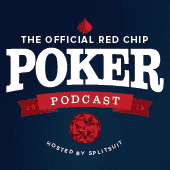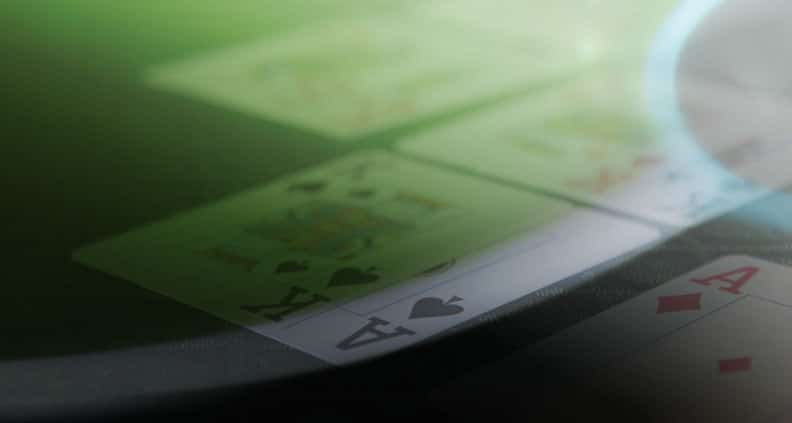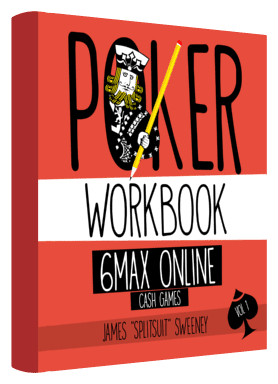Hand reading is consistently the most frequently requested topic for our podcast. In this episode, James “SplitSuit” Sweeney answers five questions submitted by Red Chippers on the subject of hand reading. He covers hand reading LAGs and loose passives, how to study hand reading skills off-table to develop profitable intuition at the tables.

Reading LAGs
How do you give a hand range to a LAG who plays any two cards? – Lee
SplitSuit says it’s first important to understand the difference between a true LAG and a massive fish. A massive fish might play any two cards, but a LAG won’t. They’ll play a tremendous amount of hands, but they actually have a thought process.
For example, when a LAG is playing a wide range of hands and they call our EP raise on the button.
First, we can narrow their range by considering that they would be 3-betting with their premium hands like QQ+ and AK. If they are a thinking LAG, they are not literally playing any two cards, though their position on the button makes it likely they are playing a fairly wide range that can include suited connectors, baby pairs, and even some suited gappers and broadway cards with middling kickers.
Reading Loose Passive Players
Are there any tips on how to get a read on loose passive players? Some of my worst mistakes are betting into their calls on the river. – Tom
Loose passive players are generally fishy, playing far too many hands, fit-or-folding often, and making very nitty raises. Their ranges are quite easy to determine.
These players would flat pre-flop with hands that most of us thinking players would 3-bet, including hands we would consider at the top of our range.
Consider that these players will have wide ranges that will be stickier. Therefore, you will value bet them more and more often, including thin value bets where you will occasionally run into a hand. Don’t take that as a mistake necessarily, take that as feedback that you are going for value and taking the risk along with it.
SplitSuit’s other tip is with post-flop play. You’re going to see more showdowns from these players due to the fishy way they play. Pay close attention to when they are and aren’t being aggressive. Think about how their range connects with the flop and use the information you gathered to exploit their tendencies in those types of spots.

Hand Reading at Micros and Tightening Up
Hand reading at the micros — 2NL, 5NL, that sort of thing — people open raise with 85o under the gun, call raises with J3 suited, call 3-bets with 42s, and while consistently winning small pots off them, I lose big pots because I cannot put them on these hands. The solution for me was to turn into a huge nit, playing fit or fold. I feel this is detrimental to my development as a player. Also, I feel I lose money because I feel like I win less. My bankroll does not allow me to just step into small stakes.
– Mircea
The last part of the question harkens back to the idea that if you move up, people will respect your raises more. Conversely, you are going to encounter better and better players as you move up. Sure, it’s frustrating to play versus these wide ranges and get sucked out on so often. But the solution is not to run away from it, the solution is to understand it better.
Related Podcast
Being a Nit is Bad for Your Health
Whether you’re playing against someone who’s playing a wide range passively or aggressively, apply the same strategy. Put them on a specific wide range, containing specific groups of hands. Consider the player’s mental state and hand history when putting them on this range for added accuracy.
Yes, these players will sneak in with a weird made hand. But when they’re playing these random wide ranges, they’re also going to show up with middle and bottom pairs they get sticky with, or a top pair you have dominated. Your edge there should more than balance out the occasional beat put on you by a fish.
Enjoy the variance. It’s baked into the game. Just go for value, value, value and rake it in over the long term.
Developing Hand Reading Skills
Are there any techniques you use to hand read more efficiently when multi-tabling? I’ve been working really hard on my hand reading skills lately, but struggle to apply them when I play more tables. Or, is it just a case of playing less tables until I’m ready? – Joby
SplitSuit says to focus on developing hand reading skills off the table until they are second nature. And one of the ways to do that in online poker is to really focus on interpreting HUD stats in depth. You want to be able to turn those HUD stats into legitimate ranges. You can work on this off the table.
Go through your database, look at HUD stats, think about ranges, pull out PokerTracker or Equilab, plug in those ranges. Extrapolate those stats into ranges you build off-table and look at all the data from all angles. Eventually, you will develop an intuition you can apply to real-time hand reading.
And, SplitSuit says, if you think you need to play fewer tables, you probably do. Fewer tables will give you more focus, naturally.
Daily Hand Reading Exercises
Besides analyzing hands, what kind of daily exercise could a player do to practice hand reading? This can be with Flopzilla or something else. Also, how can players keep track of their progress with this exercise? – Paul
SplitSuit wishes more people would ask this question. You’re not going to become a great poker player than listening to the occasional podcast or watching the occasional YouTube video. Making the best decisions in a limited time is going to require much more active study. Developing on-table intuition starts with off-table play.
SplitSuit suggests as a daily exercise to break down one hand each day, in as much depth as you feel you can go. Analyze every decision from every angle, and use poker strategy software to gain greater insight.


The average person cannot afford your rates.
I totally understand – this is also why I release a ton of free content =)